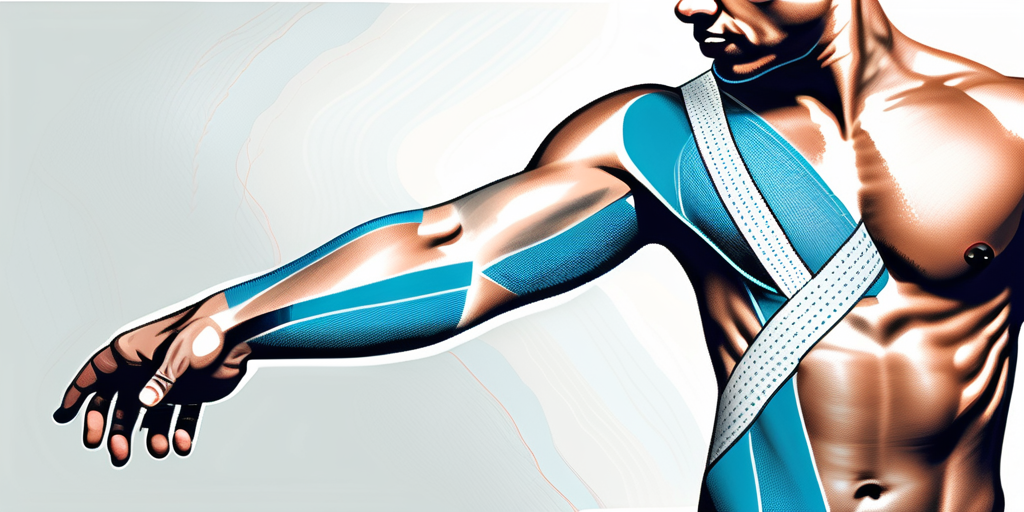Kinesiology tape has gained popularity recently, becoming a go-to tool for athletes and individuals seeking pain relief and support for their muscles and joints. But how does this colorful tape work?
This article will explore the science behind kinesiology tape and its various applications. From its basics to its mechanisms of action, we will uncover the secrets behind this remarkable tool.
Understanding the Basics of Kinesiology Tape
Before diving into the intricacies of kinesiology tape’s functionality, it is crucial to understand its fundamental principles. Unlike traditional athletic tape, which aims to restrict movement and provide rigid support, the tape used by kinesiologists is designed to facilitate movement while offering gentle support and pain relief.
This tape is meticulously crafted from elastic cotton fibers to deliver unparalleled flexibility, breathability, and comfort for the user.

The History and Development of Taping in Kinesiology
Kinesiology tape originated in the 1970s when Dr. Kenzo Kase, a Japanese chiropractor, developed a new approach to treating musculoskeletal injuries. Dr. Kase recognized the limitations of traditional tapes and created a tape that mimicked the properties of human skin. Through careful experimentation and research, he formulated the concept of kinesiology taping based on his understanding of human anatomy, physiology, and biomechanics.
Dr. Kase’s groundbreaking work revolutionized the field of sports medicine and rehabilitation. His innovative tape provided support and pain relief and enhanced the body’s natural healing processes. The elastic cotton fibers of kinesiology tape mimic the elasticity and breathability of human skin, allowing for optimal movement and comfort.
Since its inception, kinesiology taping has undergone continuous refinement and improvement. Today, healthcare professionals, athletic trainers, and individuals extensively use it to tackle various conditions, from sports injuries to chronic pain. The versatility and effectiveness of kinesiology tape have made it a staple in sports and rehabilitation.
How Kinesiology Tape Differs from Traditional Athletic Tape
While kinesiology and traditional athletic tape support muscles and joints, they employ different approaches to achieve their goals.
Traditional athletic tape primarily provides immobilization and stability. It restricts movement and offers rigid support to injured areas, commonly used in sports like boxing or weightlifting. However, traditional athletic tape can limit the body’s natural range of motion and hinder healing.
In contrast, kinesiology tape allows for a wider range of motion while providing support and pain relief. Its elastic properties promote healthy movement patterns without compromising stability, making it an excellent choice for athletes who need to maintain their agility and flexibility while recovering from an injury.
Additionally, traditional athletic tape is usually applied in a specific pattern to restrict movement. In contrast, kinesiology tape can be utilized in multiple ways, depending on the intended outcome. Its versatility and adaptability make it invaluable for treating various conditions. Kinesiology tape addresses specific requirements, such as reducing swelling, boosting muscle function, or easing discomfort.
Mechanisms of Action: How Kinesiology Tape Supports Muscles and Joints
Now that we understand the basics, let’s explore how kinesiology tape works magic.
One of the fundamental mechanisms behind kinesiology tape’s effectiveness is its ability to lift the skin, creating space between the layers. This lifting action has several beneficial effects on the body. First and foremost, it enhances blood and lymphatic circulation, improving nutrient and waste exchange in the tissues. By increasing circulation, kinesiology tape aids in reducing inflammation and promoting faster recovery.
The lift provided by the tape also supports and stabilizes muscles and joints. When applied correctly, kinesiology tape can help alleviate muscle tension and pain by facilitating proper biomechanical alignment. It is a gentle reminder to the body, encouraging correct movement patterns and reducing stress on injured or overused areas.
Additionally, kinesiology tape provides sensory feedback to the body, enhancing proprioception—our sense of position and movement. Stimulating the skin and underlying tissues creates sensory input, allowing the brain and muscles to communicate better. This heightened proprioception can improve coordination, balance, and overall athletic performance.
Moreover, it is versatile in its application. It can be used not only for injury rehabilitation but also as a preventive measure. Athletes often use tape to support muscles and joints during intense training sessions or competitions, reducing the risk of strains or sprains.
Furthermore, the adhesive properties of kinesiology tape are designed to withstand various environmental conditions, making it suitable for use during water-based activities or in hot and humid climates. This durability ensures that the tape remains in place and continues to provide support and feedback to the body, even during rigorous physical activities.
Typical Applications and Benefits of Kinesiology Tape
The versatile kinesiology tape is an essential tool that kinesiologists can use for various applications.
One everyday use of kinesiology tape is in the management of sports-related injuries. Whether sprained ankles, strained muscles, or tendinitis, kinesiology tape can provide targeted support and pain relief to help athletes get back on their feet and in the game. Its ability to promote blood flow and reduce inflammation makes it an excellent tool for injury rehabilitation.
Beyond sports injuries, kinesiology tape can benefit individuals with chronic pain conditions like arthritis or fibromyalgia. Providing gentle compression and support can help alleviate pain and improve function in affected areas.
Kinesiology tape is an essential tool in physical therapy and rehabilitation. It plays a crucial role in rehabilitation programs by facilitating muscle retraining, correcting posture, and stabilizing joints.
In addition to these applications, kinesiology tape has found its way into dance. Dancers often push their bodies to the limit, subjecting themselves to intense physical demands. Kinesiology tape can support and protect vulnerable areas, such as the ankles, knees, and wrists, allowing dancers to perform confidently and reduce the risk of injury.
Furthermore, kinesiology tape has gained popularity in pregnancy and postpartum care. It can support the abdomen and lower back, helping alleviate discomfort and promote proper posture during pregnancy. After childbirth, kinesiology tape can aid recovery by providing gentle support to the abdominal muscles and promoting proper alignment.
It is important to note that while kinesiology tape can offer significant benefits, it is not a cure-all solution. It should be part of a comprehensive treatment plan alongside appropriate medical or professional advice.
Kinesiology tape proliferates in various sectors thanks to its unique properties and proven effectiveness. By understanding how this remarkable tape works, we can better appreciate its potential to support our bodies and enhance our well-being.
Embracing the Benefits of Kinesiology
Kinesiology has become a staple in sports and rehabilitation due to its unique properties and proven effectiveness. Its ability to provide support while allowing for a wide range of motion makes it an invaluable tool for athletes and individuals alike.
From enhancing blood flow and reducing inflammation to improving proprioception and preventing injuries, kinesiology tape offers a versatile and holistic approach to musculoskeletal health. Whether you’re an athlete recovering from an injury or someone dealing with chronic pain, kinesiology tape can play a significant role in your overall treatment plan.
Embracing this innovative tool can lead to better performance, faster recovery, and improved quality of life.



